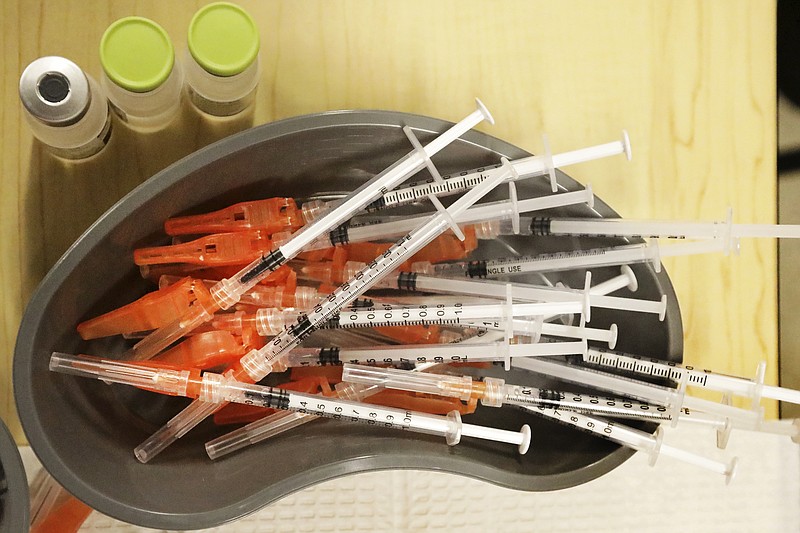The Food and Drug Administration's scientific advisers said Thursday that the next round of shots in the U.S. should only include protection against the newest variants of covid-19 that are now dominant worldwide -- a branch of the omicron family tree named XBB.
The committee's recommendation will be reviewed by the FDA. The U.S. Centers for Disease Control and Prevention also is expected to weigh in on the matter, with its Advisory Committee on Immunization Practices scheduled to discuss covid-19 vaccines on June 23.
Virtually all versions of the coronavirus currently circulating in the U.S. are descendants of the original omicron variant that walloped the nation in late 2021 and early 2022. But among those, the XBB family -- which includes XBB.1.5 and XBB.1.16, unofficially dubbed "Kraken" and "Arcturus," respectively -- is dominant almost to the point of monopoly.
While infections have declined, the virus could be a real concern next winter, FDA's vaccine chief Dr. Peter Marks said as the daylong meeting began.
"We're concerned that we may have another wave of covid-19 during a time when the virus has further evolved, immunity of the population has waned further, and we move indoors for wintertime," he said.
The FDA had told Americans to expect an updated fall vaccine against covid-19, just like they get a new flu shot every fall. Even though most of the population has either been infected or had at least one round of vaccinations, the coronavirus keeps churning out new varieties.
What's in use in the U.S. now are combination shots from Pfizer and Moderna that mix the original strain with protection against last year's most common omicron variants, called BA.4 and BA.5. But just 17% of Americans rolled up their sleeves for a combo booster.
And while the FDA did allow seniors and others at high risk to get an extra booster dose this spring, most people will be many months beyond their last shot by fall.
Those currently available shots do still help prevent severe disease and death even as XBB variants have taken over. But protection gradually wanes over time and was short-lived against milder infection even before the virus, inevitably, evolved again.
"We need a better vaccine. We should be updating it," said one adviser, Dr. Eric Rubin, an infectious-disease doctor at Brigham and Women's Hospital in Boston.
Last year when regulators were struggling to decide how to update the vaccine, a combo shot seemed like the safest bet. Omicron was pretty new, and there was no way to know how long it would stick around or if the next big coronavirus change would more resemble the original strain.
Keeping the original strain in the shot actually has a downside called "imprinting." After repeated exposure to the original strain, people's immune systems tended to recognize and respond more strongly to it than to the half of the new booster dose that was brand new.
The FDA advisory panel agreed that the fall shot should just target XBB variants. The World Health Organization's vaccine advisers and European regulators recently made similar recommendations.
"It's a great idea to base the vaccine on what's circulating right now," UC San Francisco infectious-diseases expert Dr. Peter Chin-Hong said in an interview. "And XBB is the main game in town. It's been around for some time now. It probably will continue to be dominant."
Given recent patterns over the past year, the coronavirus has been evolving more incrementally, Chin-Hong said. So he said picking a vaccine formula based on a current dominant subvariant is likely to still be helpful heading into the fall and winter, when some officials and experts expect a degree of resurgence.
Regulators will be making their best guess for what XBB variant to target, just like they do every year in setting the recipe for the fall flu vaccine.
The FDA has identified three XBB subtypes as the top strain choices. Vaccine makers already have been developing XBB-targeted formulas. At the meeting Thursday, there was a consensus that this fall's vaccine target variant XBB.1.5, the most common version infecting people in recent months.
In the U.S., XBB.1.5 made up the majority of circulating virus in the early spring but now is estimated to comprise about 40% of specimens, CDC figures show. The upstart XBB.1.16 is gaining ground and is now estimated to make up 18% of cases nationwide.
Information for this article was contributed by Lauran Neergaard and Mike Stobbe of The Associated Press and by Luke Money and Rong-Gong Lin II of The Los Angeles Times (TNS).

